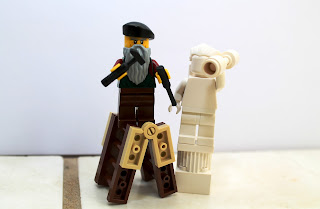 |
| Michelangelo (1475-1564) |
In 1488 he became an apprentice to the painter Domenico Ghirlandaio. He then lived in the household of Lorenzo de' Medici, the leading patron of the arts and ruler of Florence. In 1496, the Medici were expelled from Florence, Michelangelo then travelled to Bologna and then Rome.In 1497, he was able to make a name for himself after his 'Pieta'. He then returned to Florence. Here produced one of his most famous pieces, 'David' 1501-1504.
He was recalled to Rome in 1505 by Pope Julius II to design Julius' tomb. However, the project was never completed because of quarrels between Julius and Michelangelo, and other projects he had going on at the sametime. Michelangelo was later commissioned to do the ceiling of the Sistine Chapel in the Vatican (1508-1512).
 |
| Michelangelo making 'David' 1501-1504 |
He the died in Rome on 18th February 1564.


